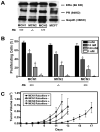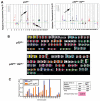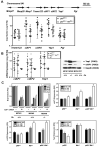Rb inactivation accelerates neoplastic growth and substitutes for recurrent amplification of cIAP1, cIAP2 and Yap1 in sporadic mammary carcinoma associated with p53 deficiency
- PMID: 20676140
- PMCID: PMC2967730
- DOI: 10.1038/onc.2010.300
Rb inactivation accelerates neoplastic growth and substitutes for recurrent amplification of cIAP1, cIAP2 and Yap1 in sporadic mammary carcinoma associated with p53 deficiency
Erratum in
-
Correction to: Rb inactivation accelerates neoplastic growth and substitutes for recurrent amplification of cIAP1, cIAP2 and Yap1 in sporadic mammary carcinoma associated with p53 deficiency.Oncogene. 2021 Mar;40(9):1754. doi: 10.1038/s41388-021-01647-2. Oncogene. 2021. PMID: 33510357 No abstract available.
Abstract
Genetically defined mouse models offer an important tool to identify critical secondary genetic alterations with relevance to human cancer pathogenesis. We used newly generated MMTV-Cre105Ayn mice to inactivate p53 and/or Rb strictly in the mammary epithelium, and to determine recurrent genomic changes associated with deficiencies of these genes. p53 inactivation led to formation of estrogen receptor-positive raloxifene-responsive mammary carcinomas with features of luminal subtype B. Rb deficiency was insufficient to initiate carcinogenesis but promoted genomic instability and growth rate of neoplasms associated with p53 inactivation. Genome-wide analysis of mammary carcinomas identified a recurrent amplification at chromosome band 9A1, a locus orthologous to human 11q22, which contains protooncogenes cIAP1 (Birc2), cIAP2 (Birc3) and Yap1. It is interesting that this amplicon was preferentially detected in carcinomas carrying wild-type Rb. However, all three genes were overexpressed in carcinomas with p53 and Rb inactivation, likely due to E2F-mediated transactivation, and cooperated in carcinogenesis according to gene knockdown experiments. These findings establish a model of luminal subtype B mammary carcinoma, identify critical role of cIAP1, cIAP2 and Yap1 co-expression in mammary carcinogenesis and provide an explanation for the lack of recurrent amplifications of cIAP1, cIAP2 and Yap1 in some tumors with frequent Rb deficiency, such as mammary carcinoma.
Figures






Similar articles
-
MMP13, Birc2 (cIAP1), and Birc3 (cIAP2), amplified on chromosome 9, collaborate with p53 deficiency in mouse osteosarcoma progression.Cancer Res. 2009 Mar 15;69(6):2559-67. doi: 10.1158/0008-5472.CAN-08-2929. Epub 2009 Mar 10. Cancer Res. 2009. PMID: 19276372 Free PMC article.
-
Correction to: Rb inactivation accelerates neoplastic growth and substitutes for recurrent amplification of cIAP1, cIAP2 and Yap1 in sporadic mammary carcinoma associated with p53 deficiency.Oncogene. 2021 Mar;40(9):1754. doi: 10.1038/s41388-021-01647-2. Oncogene. 2021. PMID: 33510357 No abstract available.
-
cIAP2 represses IKKα/β-mediated activation of MDM2 to prevent p53 degradation.Cell Cycle. 2012 Nov 1;11(21):4009-19. doi: 10.4161/cc.22223. Epub 2012 Oct 3. Cell Cycle. 2012. PMID: 23032264 Free PMC article.
-
The role of p53 loss in genomic instability and tumor progression in a murine mammary cancer model.Prog Clin Biol Res. 1996;395:1-11. Prog Clin Biol Res. 1996. PMID: 8895979 Review. No abstract available.
-
Genetic instability as a consequence of inappropriate entry into and progression through S-phase.Cancer Metastasis Rev. 1995 Mar;14(1):59-73. doi: 10.1007/BF00690212. Cancer Metastasis Rev. 1995. PMID: 7606822 Review.
Cited by
-
Cellular inhibitor of apoptosis protein-1 (cIAP1) can regulate E2F1 transcription factor-mediated control of cyclin transcription.J Biol Chem. 2011 Jul 29;286(30):26406-17. doi: 10.1074/jbc.M110.191239. Epub 2011 Jun 8. J Biol Chem. 2011. PMID: 21653699 Free PMC article.
-
Induced p53 loss in mouse luminal cells causes clonal expansion and development of mammary tumours.Nat Commun. 2017 Feb 13;8:14431. doi: 10.1038/ncomms14431. Nat Commun. 2017. PMID: 28194015 Free PMC article.
-
IAP proteins as targets for drug development in oncology.Onco Targets Ther. 2013 Sep 16;9:1285-304. doi: 10.2147/OTT.S33375. Onco Targets Ther. 2013. PMID: 24092992 Free PMC article. Review.
-
Tumor Suppressor Protein p53 and Inhibitor of Apoptosis Proteins in Colorectal Cancer-A Promising Signaling Network for Therapeutic Interventions.Cancers (Basel). 2021 Feb 4;13(4):624. doi: 10.3390/cancers13040624. Cancers (Basel). 2021. PMID: 33557398 Free PMC article. Review.
-
Anti-apoptotic factor Birc3 is up-regulated by ELL2 knockdown and stimulates proliferation in LNCaP cells.Am J Clin Exp Urol. 2019 Aug 15;7(4):223-231. eCollection 2019. Am J Clin Exp Urol. 2019. PMID: 31511829 Free PMC article.
References
-
- Borresen-Dale AL. TP53 and breast cancer. Hum Mutat. 2003;21:292–300. - PubMed
-
- Bosco EE, Knudsen ES. RB in breast cancer: at the crossroads of tumorigenesis and treatment. Cell Cycle. 2007;6:667–671. - PubMed
-
- Cardiff RD, Anver MR, Gusterson BA, Hennighausen L, Jensen RA, Merino MJ, et al. The mammary pathology of genetically engineered mice: the consensus report and recommendations from the Annapolis meeting. Oncogene. 2000;19:968–988. - PubMed
-
- Chai Y, Jiang X, Ito Y, Bringas P, Han J, Rowitch DH, et al. Fate of the mammalian cranial neural crest during tooth and mandibular morphogenesis. Development. 2000;127:1671–1679. - PubMed
Publication types
MeSH terms
Substances
Grants and funding
LinkOut - more resources
Full Text Sources
Molecular Biology Databases
Research Materials
Miscellaneous

